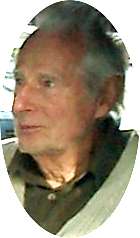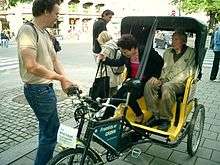Arne Næss
| Arne Næss | |
|---|---|
 Arne Næss in 2003 | |
| Born |
Arne Dekke Eide Næss 27 January 1912 Slemdal, Oslo, Norway[1][2] |
| Died | 12 January 2009 (aged 96) |
| Era | 20th-century philosophy |
| Region | Western Philosophy |
| School | Deep ecology |
Main interests |
Environmental ethics Philosophy of science |
Arne Dekke Eide Næss (AR-nə NASS;[note 1] 27 January 1912 – 12 January 2009) was a Norwegian philosopher who coined the term "deep ecology" and was an important intellectual and inspirational figure within the environmental movement of the late twentieth century.[6] Næss cited Rachel Carson's 1962 book Silent Spring as being a key influence in his vision of deep ecology. Næss combined his ecological vision with Gandhian nonviolence and on several occasions participated in direct action.
Næss averred that while western environmental groups of the early post-war period had raised public awareness of the environmental issues of the time, they had largely failed to have insight into and address what he argued were the underlying cultural and philosophical background to these problems. Naess believed that the environmental crisis of the twentieth century had arisen due to certain unspoken philosophical presuppositions and attitudes within modern western developed societies which remained unacknowledged.[7]
He thereby distinguished between what he called deep and shallow ecological thinking. In contrast to the prevailing utilitarian pragmatism of western businesses and governments he advocated that a true understanding of nature would give rise to a point of view that appreciates the value of biological diversity, understanding that each living thing is dependent on the existence of other creatures in the complex web of interrelationships that is the natural world.[7]
Life and career
Næss was born in Slemdal, Oslo, Norway, the son of Christine (Dekke) and Ragnar Eide Næss.[8] In 1939, Næss was the youngest person to be appointed full professor at the University of Oslo and the only professor of philosophy in the country at the time.[9] He was a noted mountaineer, who in 1950 led the expedition that made the first ascent of Tirich Mir (7,708 m). The Tvergastein hut in the Hallingskarvet massif played an important role in Ecosophy T, as "T" is said to represent his mountain hut Tvergastein.[10] In 1958, he founded the interdisciplinary journal of philosophy Inquiry.[11]

In 1970, together with a large number of protesters, he chained himself to rocks in front of Mardalsfossen, a waterfall in a Norwegian fjord, and refused to descend until plans to build a dam were dropped. Though the demonstrators were carried away by police and the dam was eventually built, the demonstration launched a more activist phase of Norwegian environmentalism.[12]
In 1996, he won the Swedish Academy Nordic Prize, known as the 'little Nobel'. In 2005 he was decorated as a Commander with Star of the Royal Norwegian Order of St. Olav for socially useful work. Næss was a minor political candidate for the Norwegian Green Party in 2005.[13]
Philosophy
Næss' Erkenntnis und wissenschaftliches Verhalten (1936) anticipated many themes familiar in post-war analytic philosophy.[14] Næss' main philosophical work from the 1950s was entitled "Interpretation and Preciseness". This was an application of set theory to the problems of language interpretation, extending the work of semanticists such as Charles Kay Ogden in The Meaning of Meaning. A simple way of explaining it is that any given utterance (word, phrase, or sentence) can be considered as having different potential interpretations, depending on prevailing language norms, the characteristics of particular persons or groups of users, and the language situation in which the utterance occurred. These differing interpretations are to be formulated in more precise language represented as subsets of the original utterance. Each subset can, in its turn, have further subsets (theoretically ad infinitum). The advantages of this conceptualisation of interpretation are various. It enables systematic demonstration of possible interpretation, making possible evaluation of which are the more and less "reasonable interpretations". It is a logical instrument for demonstrating language vagueness, undue generalisation, conflation, pseudo-agreement and effective communication.[15]
Næss developed a simplified, practical textbook embodying these advantages, entitled Communication and Argument, which became a valued introduction to this pragmatics or "language logic", and was used over many decades as a sine qua non for the preparatory examination at the University of Oslo, later known as "Examen Philosophicum" ("Exphil").[16]
Recommendations for public debate
Communication and Argument included his recommendations for objective public debate. Næss argued for adhering to the following rules to make discussions as fruitful and pleasant as possible:
- Avoid tendentious irrelevance
Examples: Personal attacks, claims of opponents' motivation, explaining reasons for an argument. - Avoid tendentious quoting
Quotes should not be edited regarding the subject of the debate. - Avoid tendentious ambiguity
Ambiguity can be exploited to support criticism. - Avoid tendentious use of straw men
Assigning views to the opponent that he or she does not hold. - Avoid tendentious statements of fact
Information put forward should never be untrue or incomplete, and one should not withhold relevant information. - Avoid tendentious tone of presentation
Examples: irony, sarcasm, pejoratives, exaggeration, subtle (or open) threats.[17]
For many years these points were part of two compulsory courses in philosophy taught in Norwegian universities ("Examen philosophicum" and "Examen facultatum").
Ecosophy T
Ecosophy T, as distinct from deep ecology, was originally the name of his personal philosophy. Others such as Warwick Fox have interpreted deep ecology as a commitment to ecosophy T, Næss's personal beliefs. The T referred to Tvergastein, a mountain hut where he wrote many of his books, and reflected Næss's view that everyone should develop his own philosophy.[18]
Although a very rich and complex philosophy, Næss's ecosophy can be summed up as having Self-realization as its core. According to Næss, every being, whether human, animal or vegetable has an equal right to live and to blossom.[19] Through this capitalized Self, Næss emphasizes, in distinction to realization of man’s narrow selves, the realization of our selves as part of an ecospheric whole. It is in this whole that our true ecological Self can be realized. Practically Self-realization for Næss means that, if one does not know how the outcomes of one's actions will affect other beings, one should not act,[20] similar to the liberal harm principle.
Family
Næss' father, Ragnar Næss, was a successful banker and Næss was the younger brother of shipowner Erling Dekke Næss.[21] Næss himself was a married father of two and was the uncle of mountaineer and businessman Arne Næss Jr. (1937–2004), who was once married to Diana Ross.[22]
Works
- Harold Glasser (ed), ed. (2005). The Selected Works of Arne Naess, Volumes 1-10. Springer. ISBN 1-4020-3727-9. (review)
- Communication and Argument, Elements of Applied Semantics, translated from the Norwegian by Alastair Hannay, London, Allen & Unwin, 1966.
- Scepticism, New York, Humanities Press, 1968.
- Ecology, community, and lifestyle, Cambridge, Cambridge University Press, 1989
Notes
- ↑ English pronunciation: /ˈɑːrnə ˈnæs/, AR-nə NASS; Norwegian pronunciation: [ˈnɛs], NESS
References
- 1 2 3 4 5 Schwarz, Walter (2009-01-15). "Arne Næss". The Guardian. London.
- ↑ Grimes, William (2009-01-15). "Arne Naess, Norwegian Philosopher, Dies at 96". The New York Times.
- ↑ Naess, Arne. Translated and edited by Rothenberg, David. Ecology, Community and Lifestyle. (page 10).
- 1 2 http://www.noelgcharlton.info/9DeepEcology.html
- ↑ A. Næss "Heidegger, Postmodern Theory and Deep Ecology," Trumpeter 14, no. 4 (1997).
- ↑ Krabbe, Erik C. (2010). "Arne Næss (1912-2009)". Argumentation. 24 (4): 527–30. doi:10.1007/s10503-010-9188-1.
- 1 2 Luke, Timothy W. (June 2002). "Deep ecology: Living as if nature mattered". Organization & Environment. 15 (2): 178–186. doi:10.1177/10826602015002005.
- ↑ http://www.boslekt.com/html/fam291xx/fam29101.htm
- ↑ Krabbe, Erik C. (2010). "Arne Næss (1912-2009)". Argumentation. 24 (4): 527–530. doi:10.1007/s10503-010-9188-1.
- ↑ Arne Naess 1989, Ecology Community and Lifestyle, (trans) David Rothenberg, CUP, Cambridge, p. 4
- ↑ Krabbe, Erik C. (2010). "Arne Næss (1912-2009)". Argumentation. 24 (4): 527–530. doi:10.1007/s10503-010-9188-1.
- ↑ J. Seed, J. Macy, P. Flemming, A. Naess, Thinking like a mountain: towards a council of all beings, Heritic Books (1988), ISBN 0-946097-26-7, ISBN 0-86571-133-X
- ↑ Statistics Norway (2005). "Storting Election 2005. Official electoral lists, by county". Storting Election 2005. Archived from the original on 2007-07-02. Retrieved 2007-04-17.
- ↑ Hannay, Alastair (1995). Honderich, Ted, ed. The Oxford Companion to Philosophy. Oxford: Oxford University Press. p. 627. ISBN 0-19-866132-0.
- ↑ Eriksson, Darek (2007). "Phenomeno-semantic complexity: A proposal for an alternative notion of complexity as a foundation for the management of complexity in human affairs". Complexity and Organization. 9 (1): 11–21.
- ↑ Krabbe, Erik C W (2010). "Arne Næss (1912-2009)". Argumentation. 24 (4): 528. doi:10.1007/s10503-010-9188-1.
- ↑ Krabbe, Erik C W (2010). "Arne Næss (1912-2009)". Argumentation. 24 (4): 529. doi:10.1007/s10503-010-9188-1.
- ↑ Murray Bookchin, Graham Purchase, Brian Morris, Rodney Aitchtey, Robert Hart, Chris Wilbert, Deep Ecology and Anarchism, Freedom Press (1993) ISBN 0-900384-67-0.
- ↑ Næss, Arne (1989). Ecology, community and lifestyle. Cambridge University Press. pp. 164-65
- ↑ Luke, Timothy (June 2002). "Deep ecology: Living as if nature mattered". Organization and Environment. 15 (2): 178–186. doi:10.1177/10826602015002005.
- ↑ Anonymous (Jan 27, 2009). "Philosopher and Mountaineer". The Gazette (Montreal, QC).
- ↑ Anonymous (Jan 14, 2009). "Thinker behind 'deep ecology' dies". The Ottawa Citizen (Ottawa, ON).
External links
- The Trumpeter collected works on Arne Næss vol 1 The Trumpeter collected works on Arne Næss vol 2 (2005)
- "Ecosophy from T to X" - article about Arne's philosophy, by Jim Cocola, in n+1 magazine, April 2006.
- The Trumpeter Volume 9.2 (1992)
- Arne Næss: A Biographical Sketch, by Warwick Fox.
- Arne Naess - Ecophilosophy and Ecology Page from the University of Oslo. Contains basic information about Arne Næss and his publications from 1936-2005.
- Jens Bjørneboe: How Arne Næss and I conquered NATO
- Photos of Næss' arrest at Mardalsfossen (in Norwegian)
- Inquiry An Interdiciplinary Journal of Philosophy founded by Arne Næss
- Crossing the Stones: A Portrait of Arne Naess
- The Call of the Mountain (transcript) Transcript of the film The Call of the Mountain on Arne Naess and the Deep Ecology Movement (1997)
- The Call of the Mountain (excerpts) on YouTube Excerpts of the film.
- The Call of the Mountain (complete) See "The Call of the Mountain" as one whole online
- "Arne Naess, Norwegian Philosopher, Dies at 96", New York Times obituary
- "Philosopher Developed 'Deep Ecology' Phrase", Washington Post obituary
- Arne Næss obituary in The Guardian
